|
|
 |
|
Calanoida ( Order ) |
|
|
|
Eucalanoidea ( Superfamily ) |
|
|
|
Rhincalanidae ( Family ) |
|
|
|
Rhincalanus ( Genus ) |
|
|
| |
Rhincalanus cornutus (Dana, 1849) (F,M) | |
| | | | | | | Syn.: | no Calanus rostrifrons (F) Dana,1849;
Eucalanus cornutus : Sars, 1912 a (p.654);
No Rhincalanus cornutus : Brady, 1883, p.41, figs.F); Giesbrecht, 1892 (part., p.153, 160, 774, figs.F,M); Vives & Shmeleva, 2007 (p.886, figs.F,M, Rem.);
Rhincalanus cornutus atlantica Schmaus, 1917 (p.306); 1927 (p.358, 360);
R. gigas : Sewell, 1914 a (p.203);
no R. cornutus : Tanaka, 1956 (p.271);
Rhincalanus cornutus f. typica : Mazza, 1967 (p.321);
Rhincalanus cornutus : Owre & Foyo, 1967 (part., p.37, no the drawings: figs.196-198) | | | | Ref.: | | | Giesbrecht & Schmeil, 1898 (part. p.23, Rem. F;M, figs.F); [Thompson & Scott, 1903 (p.233, 242)]; [Cleve, 1904 a (p.196, as Rhinocalanus cornutus)]; [A. Scott, 1909 (p.23)]; Wolfenden, 1911 (p.194); [Sewell, 1912 (p.353, 358)]; Willey, 1918 (p.186, figs. juv.F,M); Sars, 1925 (p.22); [Sewell, 1929 (p.58)]; Farran, 1929 (part., p.208, 220); ? Sciacchitano, 1930 (p.10, figs.F,M); Wilson, 1932 a (p.35, figs.F,M); [Dakin & Colefax, 1933 (p.204)]; Rose, 1933 a (p.71, figs.F,M); Gurney, 1934 a (p.209, N, juv.1); [Farran, 1936 a (p.79)]; [Mori, 1937 (1964) (p.27, figs.F,M)]; [Dakin & Colefax, 1940 (p.95, fig. juv.)]; Wilson, 1942 a ( part., p.205); Lysholm & al., 1945 (p.9); [Vervoort, 1946 (p.116, Rem.: anomalies, figs.F)]; [C.B. Wilson, 1950 (p.318)]; Farran & Vervoort, 1951 b (n°34, p.3, fig.F); [Krishnaswamy, 1953 (p.112)]; [King & Hida, 1955 (p.11)]; [Chiba, 1956 (p.51, figs.F,M); Yamazi, 1958 (p.147, Rem.)]; [Grice, 1962 (p.181, figs.M, juv.M)]; [Ganapati & Shanthakumari, 1962 (p.7, 16)]; [Kasturirangan, 1963 (p.14, figs.F,M)]; Vervoort, 1963 b (p.100, Rem.); Unterüberbacher, 1964 (p.15, figs.F, Rem.); [De Decker, 1964 (p.16, 24, 28)]; [De Decker & Mombeck, 1964 (p.13)]; [Chen & Zhang, 1965 (p.49, 129: Rem., figs.F,M)]; Dawson, 1966 (p.176); [Grice & Hulsemann, 1967 (p.14)]; [Mullin, 1966 (p.546)]; [Saraswathy, 1966 (1967) (p.76)]; Mazza, 1967 (p.93, figs.F,M, juv., Rem.); [Vinogradov, 1968 (1970) (p.79, 81, 91, 94, 277)]; Marques, 1968 a (p.4); [Itoh, 1970 (tab.1)]; [Morris, 1970 (p.2300, 2302)]; Corral Estrada, 1970 (p.81, figs.F, Rem.: "forma atlantica"); Rader, 1970 (p.75); Shih & al., 1971 (p.39); Bowman, 1971 b (p.18, Rem.); Björnberg, 1972 (p.14, figs., Rem.N); [Heinrich, 1973 (p.95)]; Marques, 1974 (p.12); Harding, 1974 (p.141, tab.2); Vives & al., 1975 (p.35, tab.II, XII); [Marques, 1976 (p.988)]; [Tranter, 1977 (p.596)]; [Carter, 1977 (1978) (p.35)]; [Goswami & Goswami, 1979 (p.103, figs.)]; Björnberg & al., 1981 (p.621, figs.F,M); Sazhina, 1982 (p.35, figs.N); [Marques, 1982 (p.754)]; Brodsky & al., 1983 (p.202, fig.F, Rem.F,M); Roe, 1984 (p.356); Baessa de Aguiar, 1986 (1989) (p.59, Rem.); 1988 (1990) (p.183, figs.F,M, Rem. F,M, juv.); [Zheng Zhong & al., 1984 (1989) (p.229, figs.F,M)]; [Jimenez-Perez & Lara-Lara, 1988]; [Yoo, 1991 (tab.1)]; [Park & Choi, 1997 (Appendix)]; [Chihara & Murano, 1997 (p.787, Pl.96: F,M)]; [Wong & al, 1998 (tab.2)]; Bradford-Grieve & al., 1999 (p.878, 912, fig.F); Goetze, 2003 (p.2322 & suiv.); G. Harding, 2004 (p.39, figs.F,M); Boxshall & Halsey, 2004 (p.176, p.177: fig.M); Mulyadi, 2004 (p.120, figs.F,M, Rem.); Phukham, 2008 (p.127, figs.F, M); Blanco-Bercial & al., 2011 (p.103, Table 1, Biol. mol, phylogeny) | 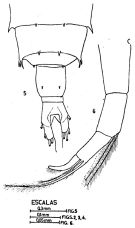 issued from : J. Corral Estrada in Tesis Doct., Univ. Madrid, A-129, Sec. Biologicas, 1970. [Lam.12, figs.5-6]. As Rhincalanus cornutus forma \\\\\\\\\\\\\\\"atlantica\\\\\\\\\\\\\\\". Female (from Canarias Is.): 5, posterior part cephalothorax and urosome (dorsal); 6, left P5. Nota: lateral spines of thoracic segments with anomalies.
|
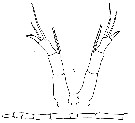 issued from : T.E. Bowman in Smithson. Contr. Zool., 1971, 96. [p.24, Fig.19, c-d]. Female (from Florida): c, P5; d, distal segments of A1 (dorsal).
|
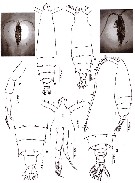 issued from : N. Phukham in Species diversity of calanoid copepods in Thai waters, Andaman Sea (Master of Science, Univ. Bangkok). 2008. [p.206, Fig.80]. Female (from W Malay Peninsula): a, habitus (dorsal); b, posterior part of thoracx and urosome (dorsal); c, forehead (dorsal); d, P5. Male: e-f, habitus (dorsal and lateral); g, last thoracic segments and urosome (dorsal); h, P5. Body length after drawings: F = 3.00 mm; M = 2.286 mm.
|
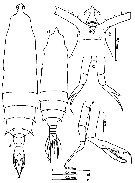 issued from : Mulyadi in Published by Res. Center Biol., Indonesia Inst. Sci. Bogor, 2004. [p.121, Fig.69]. Female (from Indonesian Seas): a, habitus (dorsal); b, forehead (ventral); c, P5. Male: d, habitus (dorsal); e, P5.
| | | | | Compl. Ref.: | | | Pearson, 1906 (p.8, Rem.); Carl, 1907 (p.16); Oliveira, 1945 (p.191); C.B. Wilson, 1950 (part., p.318); Grice & Hart, 1962 (p.287, 295: Rem.); Cervigon, 1962 (p.181, tables: abundance distribution); Gaudy, 1962 (p.93, Rem.: p.102); 1963 (p.20, Rem.); Björnberg, 1963 (p.23, Rem.); Grice & Hulsemann, 1965 (p.223); ? Mullin, 1966 (p.546, Table I, III, diet); Furuhashi, 1966 a (p.295, vertical distribution in Oyashio/Kuroshio transitional area, Table 7); Neto & Paiva, 1966 (p.20, Table III); Mazza, 1966 (p.69); Timonin, 1971 (p.281, trophic group); Deevey, 1971 (p.224); Gueredrat, 1971 (p.300, fig.3, 10, Table 1, 2); Roe, 1972 (p.277, tabl.1, tabl.2); 1972 a (p.327); Bainbridge, 1972 (p.61, Appendix Table I: vertical distribution vs day/night, Table II: %, Table IV: seasonal abundance); [Subbaraju & Krishnamurphy, 1972 (p.25, 26 )]; Brodsky, 1972 (P.256); Binet & al., 1972 (p.55, 68); Corral Estrada & Pereiro Muñoz, 1974 (tab.I); Harding, 1974 (p.141, Table 2, gut contents); [Patel, 1975 (p.659)]; Vives & al., 1975 (p.35, tab.II, IV); Deevey & Brooks, 1977 (p.256, tab.2, Station "S"); [Timonin & Voronina, 1977 (p.286, fig.4)]; [Frontier, 1977 a (p.14)]; Dessier, 1979 (p.204); [Stephen & Iyer, 1979 (p.228, tab.1, 3, 4, figs.3, 4)]; Vaissière & Séguin, 1980 (p.23, tab.1); Sreekumaran Nair & al., 1981 (p.493); Madhupratap & al., 1981 (p.262, Table 2: abundance vs. thermocline); Madhupratap & al., 1981 (p.266, fig.1n: abundance vs. geographic transect)]; Vives, 1982 (p.290); Kovalev & Shmeleva, 1982 (p.82); Dessier, 1983 (p.89, Tableau 1, 2, Rem., %); ? De Decker, 1984 (p.315, 362: chart); Tremblay & Anderson, 1984 (p.5); Cummings, 1984 (p.163, Table 2); [Guangshan & Honglin, 1984 (p.118, tab.)]; Kinzer & Schulz, 1985 (tab.4); Brenning, 1985 a (p.28, Table 2); Wishner & Allison, 1986 (tab.2); [Longhurst, 1985 (tab.2)]; [Petipa & Borichenko, 1985 (tab.1,2)]; [Renon, 1987 (tab.2)]; Lozano Soldevilla & al., 1988 (p.57); Suarez & al., 1990 (tab.2); Suarez Gasca, 1991 (tab.2); Suarez, 1992 (App.1); Huntley & Lopez, 1992 (p.201, Table B1, growth rate, temperature-dependent production); Ashjian & Wishner, 1993 (p.483, abundance, species group distributions); Seguin & al., 1993 (p.23); [Shih & Young, 1995 (p.69)]; Webber & Roff, 1995 (tab.1); Suarez-Morales & Gasca, 1997 (p.1525); Go & al., 1997 (tab.1, as corrutus); Alvarez-Cadena & al., 1998 (tab.2,3); Suarez-Morales, 1998 (p.345, Table 1); Suarez-Morales & Gasca, 1998 a (p.109); Mauchline, 1998 (tab.8, 23, 30); [Noda & al., 1998 (p.55, Table 3, occurrence)]; Neumann-Leitao & al., 1999 (p.153, tab.2); Lapernat, 2000 (tabl.3, 4); [Fernandez-Alamo & al., 2000 (p.1139, Appendix)]; Pakhomov & al., 2000 (p.1663, Table 2, transect Cape Town-SANAE antarctic base)Lopez-Salgado & al., 2000 (tab.1); Lo & al., 2001 (1139, tab.I); Fransz & Gonzalez, 2001 (p.255, tab.1); Sameoto & al., 2002 (p.13); Beaugrand & al., 2002 (p.179, figs.5, 6); [Hwang & al., 2003 (p.193, tab.2)]; [Kazmi, 2004 (p.229, Rem.: p.232]); [ Yin & al., 2004 (p.3) ]; Wang & Zuo, 2004 (p.1, Table 2, dominance, origin); [ Smith & Madhupratap, 2005 (p.214, tab.6) ]; Valdés & al., 2007 (p.103: tab.1); Khelifi-Touhami & al., 2007 (p.327, Table 1); Jitlang & al., 2008 (p.65, Table 1); McKinnon & al., 2008 (p.844: Tab.I); Neumann-Leitao & al., 2008 (p.799: Tab.II, fig.6); Morales-Ramirez & Suarez-Morales, 2008 (p.513); Fernandes, 2008 (p.465, Tabl.2); Wishner & al., 2008 (p.163, Table 2, fig.8, oxycline); Gaard & al., 2008 (p.59, Table 1, N Mid-Atlantic Ridge); Ayon & al., 2008 (p.238, Table 4: Peruvian samples); ? Pagano, 2009 (p.116); C.-Y. Lee & al., 2009 (p.151, Tab.2); Schnack-Schiel & al., 2010 (p.2064, Table 2: E Atlantic subtropical/tropical); Goetze & Ohman, 2010 (p.2110, Table 1); Dias & al., 2010 (p.230, Table 1); Mazzocchi & Di Capua, 2010 (p.425); Medellin-Mora & Navas S., 2010 (p.265, Tab. 2); W.-B. Chang & al., 2010 (p.735, Table 2, abundance); Xu & Gao, 2011 (p.514, figs.3, 4, Table 2: optimal salinity); Pepin & al., 2011 (p.273, Table 2, seasonal abundance); Tutasi & al., 2011 (p.791, Table 2, abundance distribution vs La Niña event); Andersen N.G. & al., 2011 (p.71, Fig.3: abundance); Guo & al., 2011 (p.567, table 2, indicator); Mulyadi & Rumengan, 2012 (p.202, Rem.: p.204); Salah S. & al., 2012 (p.155, Tableau 1); [Jang M.-C & al., 2012 (p.37, as R. cornatus lapsus calami, abundance and seasonal distribution)]; Teuber & al., 2013 (p.28, Table 1, respiration rates); Teuber & al., 2013 (p.1, Table 1, 2, 3, fig.5, abundance vs oxygen minimum zone, respiration rates, enzyme activity); Kobari & al., 2013 (p.78, Table 2); Jagadeesan & al., 2013 (p.27, Table 3, seasonal variation); Lidvanov & al., 2013 (p.290, Table 2, % composition); Zaafa & al., 2014 (p.67, Table I, occurrence); Bode & al., 2015 (p.268, Table 1, 2, figs.3, 4, chemical components, trophic level, geographic zone); Dias & al., 2015 (p.483, Table 2, abundance, biomass, production); Benedetti & al., 2016 (p.159, Table I, fig.1, functional characters); Marques-Rojas & Zoppi de Roa, 2017 (p.495, Table 1); Bonecker C.T. & al., 2017 (p.247, fig.9: abundance day/night vs. vertical types of mass water); El Arraj & al., 2017 (p.272, table 2, spatial distribution); Bode & al., 2018 (p.840, Table 1, respiration & ingestion rates, depth) Belmonte, 2018 (p.273, Table I: Italian zones); Dias & al., 2018 (p.1, Table 2: vertical distribution, abundance vs. season); Acha & al., 2020 (p.1, Table 3: occurrence % vs. ecoregions). | | | | NZ: | 16 | | |
|
Distribution map of Rhincalanus cornutus by geographical zones
|
| | | | | | | | | | | | 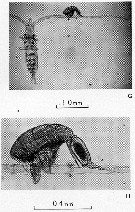 Issued from : J.H. Wickstead in Proc. Zool. Soc. London, 1962, 139 (4). [Pl. I, G-H]. Issued from : J.H. Wickstead in Proc. Zool. Soc. London, 1962, 139 (4). [Pl. I, G-H].
G: Oncaea sp. holding the antennula of Rhincalanus cornutus copepodite (G); H: Note that the mouth is applied to an antennular segment (enlargement of G). |
 Issued from : A.C.T. Bonecker, A. V. de Araujo, C.O. Dias, M.M.S. Castro, P.F. Carvalho, R.M. Lopes & S.C.L. Bonecker in A.P.C. Falcao & D.L. Moreira (ed.) Ambiente pelagico caracterizaçao ambiental regional de Bacia de Campos, Atlantico Sudoeste. Rio de Janeiro. Elsevier. 2017, v.5, p.247-281. [p.260, Fig.9] Issued from : A.C.T. Bonecker, A. V. de Araujo, C.O. Dias, M.M.S. Castro, P.F. Carvalho, R.M. Lopes & S.C.L. Bonecker in A.P.C. Falcao & D.L. Moreira (ed.) Ambiente pelagico caracterizaçao ambiental regional de Bacia de Campos, Atlantico Sudoeste. Rio de Janeiro. Elsevier. 2017, v.5, p.247-281. [p.260, Fig.9]
Abundance (ind. m-3) sampled during night and day into four water masses in the Campos Basin (Brazil).
AT: Tropical water; ACAS: Central water of South Atlantic; AIA: Intermediate water of Antarctica; ACS: Deep water Circumpolar water superior.
Sampling at station c (22°54'30''S, 40°43'W), depth 1900 m (end of the continental slope). |
 Issued from : M. Bode, R. Koppelmann, L. Teuber, W. Hagen & H. Auel inGlobal Biogeochemical Cycles, 2018, 32. [p.844, Table 1). Issued from : M. Bode, R. Koppelmann, L. Teuber, W. Hagen & H. Auel inGlobal Biogeochemical Cycles, 2018, 32. [p.844, Table 1).
Cf. explanations of these measures in Calanoides natalis from the same authors.
Compare with Rhincalanus nasutus |
| | | | Loc: | | | ? South Africa (E), Namibia, off E Tristan da Cunha , Angola, Baia Farta, Congo, Atlant. (central equatorial), G. of Guinea, off Lagos, Ivorian shelf, Dakar, Cape Verde Is., off Mauritania-NW Cape Verde Is., Morocco-Mauritania, Cap Ghir, Canary Is., off Madeira, off W Cap Finisterre, Azores, off Rio de La Plata (shelfbreak), Brazil (off Macaé, Campos Basin, Cabo Frio, off Natal, Mouth of Tocantins, off Amazon), Barbados Is., Caribbean Sea, Caribbean Colombia, Bahia de Mochima (Venezuela), Cariaco Basin, Yucatan, Jamaica, Yucatan (Ascension Bay), E Costa Rica, G. of Mexico, Caribbean, Louisiana (off Grand Isle), Florida, off Bermuda, Sargasso Sea, Station "S" (32°10'N, 64°30'W), off Hatteras Cape, off E Cape Cod, G. of Maine, off Woods Hole, Nova Scotia, off E Nova Scotia, Newfoundland, Faroe Is., W Ireland., North Sea, Ibero-moroccan Bay, off W Tangier, Medit. (M'Diq, Alboran Sea, Gulf of Annaba, Marseille, Tyrrhenian Sea, Liguro-provençal Channel, S Adriatic Sea), ? Red Sea,
? [ Natal, Madagascar (Nosy Bé), Arabian Sea, Pakistan, India (Saurashtra coast, off Cochin, Porto Novo, Gulf of Mannar, Madras), equatorial Indian Ocean, E India, Bay of Bengal, W Malay Peninsula (Andaman Sea), W Australia, Indonesian Seas (Bali Sea, Flores Sea, Banda Sea (Ambon Bay), S Celebes Sea: Manado Bay), Philippines, Viet-Nam (Cauda Bay), G. of Tonkin, Hainan (Sanya Bay), China Seas (Yellow Sea, East China Sea, Taiwan Strait, South China Sea), Taiwan, Okinawa, S Korea, Korea Strait, Japan, Kuchinoerabu Is., Kuroshio region, Bering Sea, Pacif. (W equatorial), Australia (Great Barrier, New South Wales), North West Cape), New Zealand, Pacif. (equatorial, Subarct.), off S Hawaii, G. of California, G. of Tehuantepec, W Central America, Clipperton Is., off Peru, off Galapagos, Galapagos-Ecuador, off Easter Is. ] | | | | N: | 227 ? [any to be confused] | | | | Lg.: | | | (14) F: 3,6-3,1; M: 2,6-2,4; [(28) F: 3,65-2,9; M: 2,9-2,45]; (54) F: 3,47; M: 2,7; [(92) F: 3,37]; [(101) F: 3,4-2,79; M: 2,95-2,69]; (131) F: 3,8-2,9; [(135) F: 3,5]; (180) F: 3,25-3,85; M: 2,57-2,7; (199) F: 4,16-2,81; M: 3,68-2,72; (237) F: 3,5; M: 2,5; [(290) F: 2,65-3,35; M: 2,6-2,8]; [(332) F: 3-2,6; M: 3,8-3,6]; [(333) F: 3,55-2,84; M: 2,63-2,5]; [(334) F: 3,6; M: 2,68]; (335) F: 3,45; [(530) F: 3,2]; [(795) F: 3,2)]; (1122) F: 3,3; M: 2,52; {F: 2,81-4,16; M: 2,40-3,68} | | | | Rem.: | meso-bathypelagic, sometimes near the surface. Overall Depth Range in Sargasso Sea: 0-2000 m. 1000-2000 m (Harding, 1974).
There are any confusions between R. cornutus and R. rostrifrons by the authors.
According to Bowman (1971), this species would be restricted to the Atlantic and R. rostrifrons to the Indo-Pacific (authors, locality records and dimensions between brackets). The indication of this tropical species in the North Sea appears exceptional.
Lo & al. (2001) report this species near Taiwan, as well as Rhincalanus rostrifrons, and Mulyadi (2004) in the Indonesian Seas. W. Zhang (pers. comm., nov. 2006) confirms the presence of R. cornutus in his samples from the Chinese Seas.
This species is not mentioned in the CALCOFI region, as in the West coast of Baja California (M. Ohman, pers. comm., 2014).
For Itoh (1970 a, fig.2, from co-ordonates) the Itoh's index value of the mandibular gnathobase = 240 (perhaps R. rostrifrons).
Timonin (1971, p.282) considers the trophic interrelations in the equatorial and tropical Indian Ocean, and divides the plankters into 6 trophic groups from the litterature and the results of studies of mouth-parts structure and intestine content. This species is a coarse-filter feeder. | | | Last update : 28/10/2022 | |
|
|
 Any use of this site for a publication will be mentioned with the following reference : Any use of this site for a publication will be mentioned with the following reference :
Razouls C., Desreumaux N., Kouwenberg J. and de Bovée F., 2005-2025. - Biodiversity of Marine Planktonic Copepods (morphology, geographical distribution and biological data). Sorbonne University, CNRS. Available at http://copepodes.obs-banyuls.fr/en [Accessed November 28, 2025] © copyright 2005-2025 Sorbonne University, CNRS
|
|
 |
 |









